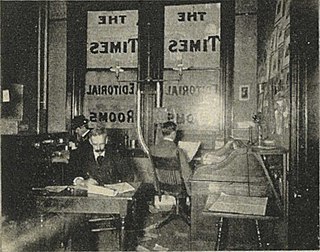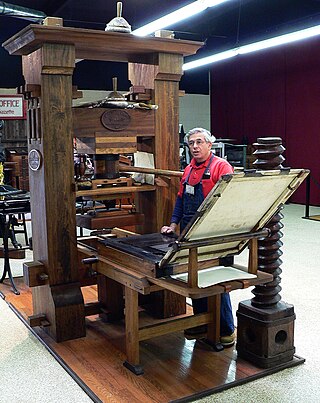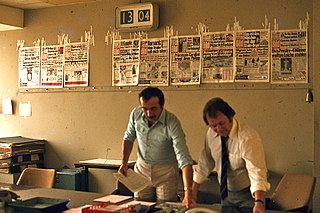Related Research Articles
In legal discourse, an author is the creator of an original work that has been published, whether that work is in written, graphic, or recorded medium. The creation of such a work is an act of authorship. Thus, a sculptor, painter, or composer, is an author of their respective sculptures, paintings, or compositions, even though in common parlance, an author is often thought of as the writer of a book, article, play, or other written work. In the case of a work for hire, the employer or commissioning party is considered the author of the work, even if they did not write or otherwise create the work, but merely instructed another individual to do so.

A book is a medium for recording information in the form of writing or images. Modern books are typically in codex format, composed of many pages that are bound together and protected by a cover; they were preceded by several earlier formats, including the scroll and the tablet. The book publishing process is the series of steps involved in their creation and dissemination.

Mass media include the diverse arrays of media that reach a large audience via mass communication.

Typography is the art and technique of arranging type to make written language legible, readable and appealing when displayed. The arrangement of type involves selecting typefaces, point sizes, line lengths, line spacing, letter spacing, and spaces between pairs of letters. The term typography is also applied to the style, arrangement, and appearance of the letters, numbers, and symbols created by the process. Type design is a closely related craft, sometimes considered part of typography; most typographers do not design typefaces, and some type designers do not consider themselves typographers. Typography also may be used as an ornamental and decorative device, unrelated to the communication of information.
Desktop publishing (DTP) is the creation of documents using dedicated software on a personal ("desktop") computer. It was first used almost exclusively for print publications, but now it also assists in the creation of various forms of online content. Desktop publishing software can generate page layouts and produce text and image content comparable to the simpler forms of traditional typography and printing. This technology allows individuals, businesses, and other organizations to self-publish a wide variety of content, from menus to magazines to books, without the expense of commercial printing.

Publishing is the activity of making information, literature, music, software, and other content available to the public for sale or free of charge. Traditionally, the term refers to the creation and distribution of printed works, such as books, comic books, newspapers, and magazines. With the advent of digital information systems, the scope has expanded to include digital publishing such as e-books, digital magazines, websites, social media, music, and video game publishing.

Editing is the process of selecting and preparing written, visual, audible, or cinematic material used by a person or an entity to convey a message or information. The editing process can involve correction, condensation, organization, and many other modifications performed with an intention of producing a correct, consistent, accurate and complete piece of work.

To publish is to make content available to the general public. While specific use of the term may vary among countries, it is usually applied to text, images, or other audio-visual content, including paper. Publication means the act of publishing, and also any copies issued for public distribution.
An advertorial is an advertisement in the form of editorial content. The term "advertorial" is a blend of the words "advertisement" and "editorial". Merriam-Webster dates the origin of the word to 1946.

Copy editing is the process of revising written material ("copy") to improve quality and readability, as well as ensuring that a text is free of errors in grammar, style, and accuracy. The Chicago Manual of Style states that manuscript editing encompasses "simple mechanical corrections through sentence-level interventions to substantial remedial work on literary style and clarity, disorganized passages, baggy prose, muddled tables and figures, and the like ". In the context of print publication, copy editing is done before typesetting and again before proofreading. Outside traditional book and journal publishing, the term "copy editing" is used more broadly, and is sometimes referred to as proofreading; the term sometimes encompasses additional tasks.

In typography, text or font in all caps contains capital letters without any lowercase letters. For example:
THE QUICK BROWN FOX JUMPS OVER THE LAZY DOG.

News design is the process of arranging material on a newspaper page, according to editorial and graphical guidelines and goals. Main editorial goals include the ordering of news stories by order of importance, while graphical considerations include readability and balanced, unobtrusive incorporation of advertising.
Atex is a company specializing in the development of advertising, editorial and web content management systems. The company was established in Massachusetts in 1973 and grew to become a worldwide hardware and software supplier to the publishing industry. It participated in much of the change in the print industry involving the move from hot-metal through photo and then laser typesetting, culminating in computer to plate (CTP). The company expanded to include web publishing as an integral part of its product line.
A weekly newspaper is a general-news or current affairs publication that is issued once or twice a week in a wide variety broadsheet, magazine, and digital formats. Similarly, a biweekly newspaper is published once every two weeks. Weekly newspapers tend to have smaller circulations than daily newspapers, and often cover smaller territories, such as one or more smaller towns, a rural county, or a few neighborhoods in a large city. Frequently, weeklies cover local news and engage in community journalism.
Copywriting is the act or occupation of writing text for the purpose of advertising or other forms of marketing. Copywriting is aimed at selling products or services. The product, called copy or sales copy, is written content that aims to increase brand awareness and ultimately persuade a person or group to take a particular action.

In graphic design, page layout is the arrangement of visual elements on a page. It generally involves organizational principles of composition to achieve specific communication objectives.
Adobe InCopy is a professional word processor made by Adobe Inc. that integrates with Adobe InDesign. InCopy is used for general word processing, in contrast to InDesign, which is used to publish printed material, including newspapers and magazines. The software enables editors to write, edit, and design documents. The software includes standard word processing features such as spell check, track changes, and word count, and has various viewing modes that allow editors to visually inspect design elements — just as it looks to the designer working in Adobe InDesign.

A newspaper is a periodical publication containing written information about current events and is often typed in black ink with a white or gray background. Newspapers can cover a wide variety of fields such as politics, business, sports, art, and science. They often include materials such as opinion columns, weather forecasts, reviews of local services, obituaries, birth notices, crosswords, editorial cartoons, comic strips, and advice columns.
The following outline is provided as an overview of and topical guide to journalism:
This glossary of journalism is a list of definitions of terms and concepts used in journalism, its sub-disciplines, and related fields, including news reporting, publishing, broadcast journalism, and various types of journalistic media.
References
- ↑ Ungerer, Friedrich (2000). English Media Texts Past and Present: Language and textual structure. Philadelphia, PA: John Benjamins Publishing Company. p. 135. ISBN 9027250995.
- ↑ Hamilton, James; Bodle, Robert; Korin, Ezequiel (2017). Explorations in Critical Studies of Advertising. New York: Routledge. p. 61. ISBN 9781138649521.
- ↑ Kobak, James (2002). How to Start a Magazine: And Publish It Profitably. New York: M. Evans and Company, Inc. p. 119. ISBN 9780871319272.